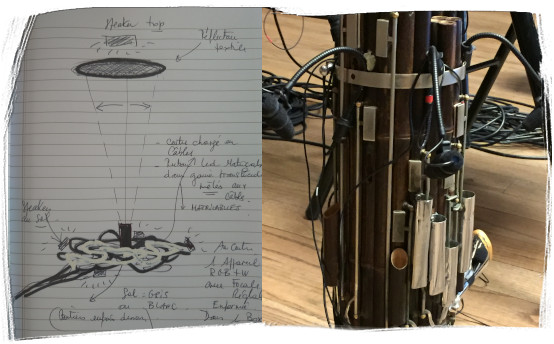
a forest of pipes
Home » music » Wu Wei, André Serre-Milan, Alexis Baskind, Forest of Pipes (May 2021, Marseille)featuring
wu wei : sheng master and composer
andré serre-milan : composer, electronic music performer
alexis baskind : performer (electronic music and sound projection), sound engineering
caty olive : light and stage design
lin-ni liao (tpmc) : project direction
the aesthetic goal of this project is to metaphorically set the listener within the 37-pipe sheng, surrounded by its pipes. the electronic extension of the modernized 37-pipe sheng (based on traditional mouth organs) is at the center of this project, which is the performance part of the sheng! research project, coordinated by TPMC – Tout pour la musique contemporaine, implying among others the research labs and institutes IReMus, IRCAM, Sorbonne Université, Inalco, and actively supported by GMEM (Marseille), Césaré (Reims).
a few words about the sheng and the 37-pipe sheng
the sheng is not one instrument but a family of instruments, which constitute some of the world’s oldest free-reed instruments. the sheng has a history of over 3,000 years: its ancestors (he and yu) were recorded in oracle bone scripts in the 15th century bc as well as in classifications of chinese instruments in historical records from the west zhou dynasty (c. 1100–771 b.c.). the sheng as such was first mentioned in the 7th century bc. it has played an important role in the development of chinese music culture, including the whole of southeastern asia. its korean version, the saenghwang (생황), is still used to play court music from the song dynasty. it was introduced in japan through the korean peninsula in the 7th century (its japanese name is shō – 笙), and is still used to play gagaku music and some court music from the tang dynasty.
the so-called 37-pipe sheng, which is the very instrument on which this project focusses, has been conceived with the explicit aim of bringing together the tradition and modernity. its design and fingering directly inherits from several traditional mouth organs (especially the hebei sheng and the japanese sho), extended to a full chromatic instrument with 3-octave range, now equally making it suitable for performing traditional chinese music, japanese gagaku music, and contemporary repertoire.
production calendar 2020-2023
august 2020 – december 2020 – preliminary scientific and artistic research in Berlin
this phase has been presented in an online seminar at ircam.
may 2021 – First residency in gmem – marseille
an improvisation performed during this residency can be heard here:
Wu Wei, André Serre-Milan, Alexis Baskind, Forest of Pipes (May 2021, Marseille)26 june 2021 – concert in eye museum (amsterdam)
a short excerpt of the performance can be heard here.
january 2022 – second residency in gmem – marseille
this residency concluded with a public performance on january 26 in gmem.
see more information on the gmem’s website (in french)
29 january 2022: public performance: premier of two compositions by andré serre-milan and wu wei
with andré serre-milan, wu wei, alexis baskind
centre national de création musicale – césaré (reims), opéra de reims
part of the FARaway festival.
20 march 2022: public performance: alexis baskind, wu wei and katrin bethge (light projection performance), maerzmusik 2022
silent green, kuppelhalle.
part of the maerzmusik 2022 festival (berliner festspiele)
30 march 2022: public performance: alexis baskind and wu wei, centro centro, madrid
centro centro, madrid
21 january 2023: public performance: two compositions by andré serre-milan and wu wei
musée des confluences, lyon
with andré serre-milan, wu wei, alexis baskind
march 2023: radio performance: “somme et différence” by julie zhu
for the program “création mondiale” presented by anne montaron, radio france, paris..
with julie zhu, wu wei, alexis baskind